Bewdley’s Big Dig
- 24th March 2023
In April and July 2022, 21 test pits were excavated across Bewdley, Worcestershire, as part of the Small Pits, Big Ideas project. Bewdley was a bit different to our other big digs, being a town rather than a village with much more development having taken place. Our objective for this dig was to find out more about the area around Bewdley before it became a town, with the help of local residents, including Bewdley Historical Research Group and students from The Bewdley School.
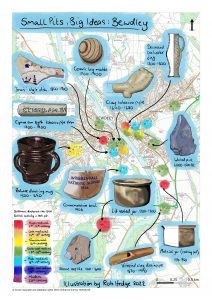
Summary of Bewdley’s test pits, showing the earliest settlement activity found and a selection of finds (created by Rob Hedge)
This community excavation was part of a wider project – Small Pits, Big Ideas – researching rural medieval settlements across the county. Together, these test pits tell a broader story of the village over time. Today our household rubbish is taken away regularly, but in the past rubbish was often thrown out the back of houses. This wasn’t just food waste, but broken pots, bits of building rubble and anything else that was old or broken. Back gardens are therefore an ideal place to look for clues. Pottery can be easily dated, as fashions for different styles changed over time. The amount of pottery found in a test pit can give us a rough idea of how nearby people lived at different times in the past.
What is a test pit?
Test pits are mini excavation areas, just 1m by 1m. They are dug in 10cm layers (called ‘spits’) with the finds from each spit kept separately, so that it’s known how deep down they were found. Test pits were mostly excavated down to the ‘natural’, which is the point at which archaeology stops and undisturbed geology begins. The depth of the Bewdley test pits varied quite widely, ranging from 0.3m – 1.4m below ground level.
Before the town – the Bewdley Area
As Bewdley has an active local research group, we know quite a bit about early Bewdley. Although the town itself is not mentioned in the Domesday book, both the settlements of Wribbenhall & Ribbesford are. It appears that the name ‘Wribbenhall’ referred to both sides of the River Severn until 1275, when the west bank started to be called ‘Bewdley’ – from ‘Beaulieu’ or ‘beautiful place’- and settlement there expanded.
A bridge was built across the river in 1448 and in 1461 Bewdley became a royal manor under Edward IV, with a royal place established at Tickenhill to the west of the town.
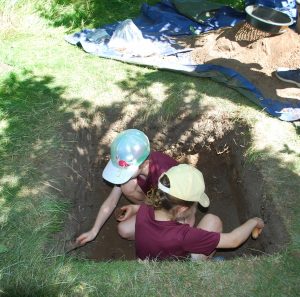
Digging a test pit – Photo Credit Sara Jennings
So what did we find?
Small amounts of prehistoric and Roman finds are typical of rural landscapes in the region, reflecting a long history of occupation. In Bewdley, these early finds were concentrated on the east side of the river, which suggests an elongated prehistoric settlement, to the south of today’s town.
As Bewdley is a built-up area, much of the underlying ground is quite churned up due to development over time, meaning that artefacts from more centrally located test pits are likely to have been moved around and damaged. However, a little further out such as at test pits 9 and 10 at Ribbesford, we found undisturbed medieval deposits that suggest 12th – 14th century settlement and we can be sure that there were medieval houses near to Ribbesford Church as we found fragments of household rubbish and building materials. In test pit 9 at Ribbesford, we found what we think is a medieval peach stone! It has been burnt, which is why it has survived and was found amongst other undisturbed medieval material. Although peaches are known to have been cultivated in England from at least the early-13th century, their remains are not commonly found and are an interesting indicator of the favourable climate of this period.
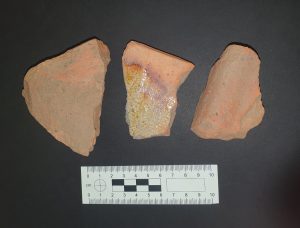 Medieval tile fragments from test pit 10 |
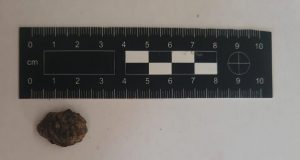 A medieval peach stone from test pit 9 |
The Wyre Hill area is thought to date from the 1460s, perhaps reflecting a period of rebuilding after damage during the Wars of the Roses. Finds from both test pits in this area support the idea of development at around this time, as neither produced any pre-1500 material.
It is also possible that we are starting to see tentative patterns in trade. Two thirds of the pre-1350 pottery found in Bewdley’s test pits came from Worcester and Malvern, a much larger amount than was seen at nearby Wolverley, just 6km to the North East. Similarly, we saw some local pottery and Staffordshire whitewares at Bewdley, but much less than at Wolverley. We also saw evidence of trading links from further afield in the pottery finds; with Ham Green pottery from Bristol and Brill-Boarstall from Buckinghamshire both present.
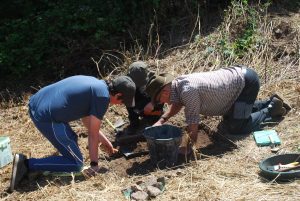
Exciting discoveries at test pit 9 – Photo credit Sara Jennings
Impact of the Black Death?
As just three test pits in Bewdley contained finds dating to mid-14th to 15th centuries (TPs 2, 7 and 12) and nothing post 14th Century was found in the Ribbesford area it is tempting to think that we could perhaps be seeing some evidence of the effect of the Black Death of the 1340’s and other crises of the early 14th Century on the area.
This may be possible, however, this is a common pattern seen in the region and the lack of medieval pottery is more likely to be due to ceramic cooking pots being replaced by metal ones. It may also be that the settlement of Ribbesford altered at this time for other reasons.
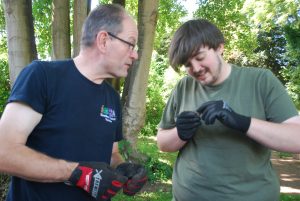
Looking at finds – Photo Credit: Sara Jennings
The growth of the later town
The post-medieval period was the time when Bewdley really flourished, largely thanks to the busy port on the riverside. Many of the buildings which are now listed on the Historic Environment register date from this period and there are records of churches, chapels, schools, hotels and public houses, assembly rooms, a prison and a brass foundry. We see evidence of this in the increase in the quality and range of finds between the 16th to the 19th centuries, reflecting both the fortunes of the town and the growing availability and affordability of goods. In particular, there was a wide range of later-18th century pottery.
Want to know more?
Keep an eye out for the full report on Bewdley’s Big Dig, which will be available from our website soon. You can also watch a talk below, which was given to the village in February 2023.
Post a Comment